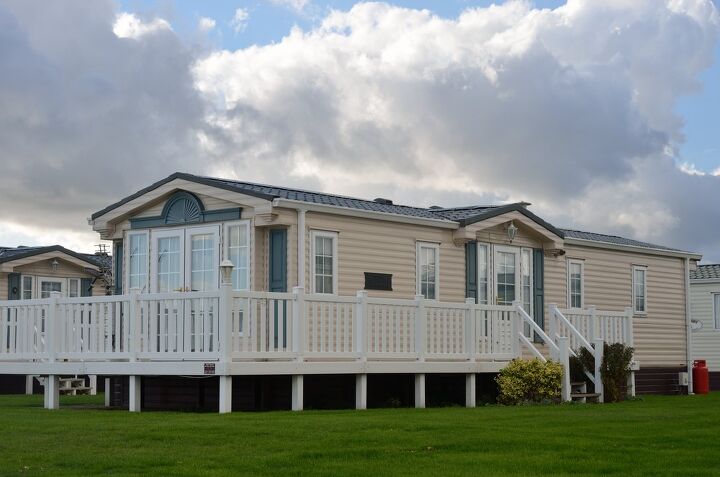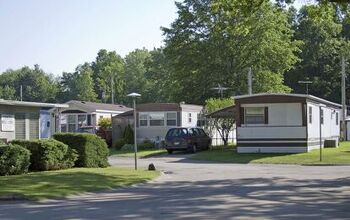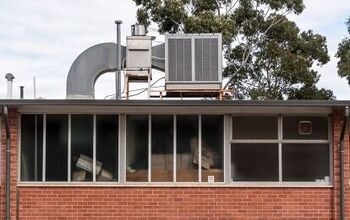How To Winterize A Mobile Home (Step-by-Step Guide)

Mobile homes are vulnerable to cold weather. Have you ever wondered why bridges have signs that read “may be icy”? The reason, unlike a road on the ground, is that cold air is traveling above and below the bridge.
The same is true with a mobile home. Since most don’t have a permanent foundation, it’s easier for air to flow underneath, which can cause freezing and bursting pipes.
To winterize your mobile home, you will need to stop the drafts and increase insulation. If you plan on leaving your mobile home vacant, you’ll need to turn off the water and drain the pipes.
Mobile homes are notorious for freezing. Any water pipes and drains need to be addressed if you plan on leaving the home empty. Taking the time to properly winterize your mobile home is a gift that keeps giving. You’ll have a warmer home that costs less to heat, and you won’t have to worry about showing up to frozen pipes.
Seven Steps to Winterize a Mobile Home
Every mobile home has unique characteristics when it comes to insulation. Some have more traditional foundations and roofs, while others can be extremely susceptible to the cold.
When walking through your mobile home, look out for the following things:
- Gaps near vents or ducts
- Windows and doors
- How much insulation is in the walls – does the roof need more insulation?
- Is the furnace in good working order?
- Relax tie-downs for freezing temperatures
- Check gutters
- Exposed pipes
We will go through this list of seven steps to winterize your mobile home. Also, at the end of these steps, we will go over several steps to winterize a vacant mobile home.
Step 1: Seal Obvious Gaps with Caulk
Think of your mobile home like a ship floating on the water. If the captain finds even the smallest leak, it must be repaired immediately. Otherwise, the ship is will eventually sink.
The same is true for your home. Even the smallest air leak can be a detriment to your home’s heating system – and where there is one leak, there is probably more.
Take caulk and fill any little cracks you may find. Look around external vents, on the roof, any seams or corners, especially around your windows and doors. If you find old caulk is brittle and peeling, gently remove it before applying a new coat. This will provide a more effective seal.
Step 2: Winterize Windows and Doors
In addition to the caulk around the seams of your windows, there are a few other ways to prevent heat loss. Windows, especially if they are old, are not good at insulation even in an optimal state. With this in mind, it’s a great idea to beef up the seals around your windows and doors.
Go around every window in your home and feel the edges with the back of your hand. Move your hand slowly. You will be able to feel if there is a draft. When you find one, take some weather stripping and line the seams. Also, after placing the weather stripping, you can cover your windows with plastic or foam boards.
Both these methods will drastically reduce heat loss near your windows.
Also, get a set of thick curtains and keep them closed at night when it’s cold. But, when the sun is shining, open your curtains and use the sun to your advantage.
See this article on winterizing a sliding patio door.
Step 3: Check Wall Insulation
Many mobile homes are built with inadequate wall insulation. Sometimes only one inch thick. While it may not be practical to completely reinsulate (though it is possible if you have the ambition), you may be able to at least add some insulation to areas like the bedrooms.
Adding insulation can be easy or difficult based on your mobile home construction. There are several techniques to boost insulation. We will cover them briefly here.
The first is to use an insulator tool that slides a sheet of insulated up under the wall. To do this, you need to open up the bottom of the wall, so you have room to slide your new piece of insulation underneath.
The second way is by cutting a small hole in the wall and blowing fiberglass insulation inside the wall’s interior. This is more useful for attics and crawlspaces where there is more room to work.
Step 4: Check the Furnace
Once you’ve made sure that the structure of your mobile home is well sealed, it’s time to address the source of your heat – the furnace.
Before you get really cold weather, inspect your furnace for any obvious malfunctions. Loose parts and worn lines should be noted. If you have an especially old furnace and or are unsure how to your furnace works, it’s wise to hire a professional to inspect your furnace and repair it if needed.
You don’t want to put yourself in the awkward situation of having freezing temperatures outside and a broken furnace. See our article on how much it costs to fix a furnace blower motor.
Step 5: Relax Tie-Downs
This is a recommended step if you are in an area where the ground will freeze. Your mobile home’s tie-downs keep your structure solid; however, in freezing temperatures, the ground will shift, potentially stressing your mobile home.
By relaxing the tie-downs, you give your mobile home some leeway. Don’t over relax the tie-downs. Usually, only relaxing about 3 inches will be sufficient. Always consult a professional if you are unsure about your tie-downs. You don’t want to do something dangerous.
Step 6: Check Gutters for Debris
Clogged gutters can be worse than no gutters at all, especially in the winter. When gutters become overwhelmed with debris, the water has nowhere to go. This means that water will pool on the roof, potentially causing rot.
In the winter, when it freezes and melts, you want any remaining water to run off your roof. However, if your gutters are full of crud, the ice will continue to build up.
It’s good practice to clean your gutters at least once a year. So, after the leaves fall and before the snow sets in, take some time to clear them out. Just be cautious when using ladders or standing on the roof.
Step 7: Protect Exposed Pipes
Water freezes, especially when it pools inside cold metal pipes. Have a look under your mobile home and see if any pipes could use some added insulation.
To insulate your pipes, you can purchase foam pipe insulation and wrap it around them. To make foam insulation even better, you can use heat tape. Heat tape is like an extension cord with a heated section. Wrap this around the exposed pipe to prevent freezing. You can also add some heat underneath your mobile home to keep the pipes warm.
Note: Inspect the integrity of the skirt around your mobile home (if it has one). You want to make sure there are no overt air leaks where air can blow underneath – especially near exposed pipes.
You should now have your mobile home fairly well insulated. If you feel that your home could be insulated better, consider hiring a professional to come to assess. Some will even do a pressure study inside your mobile home to directly measure your home’s tightness.
Steps to Winterize a Dormant Mobile Home
Here are the steps to take if you plan on leaving your mobile home unattended in the cold weather:
- Turn off water
- Drain water heater
- Blow out pipes
- Place antifreeze in all drain traps
Step 1: Turn off Water
First, shut off the main water supply to your mobile home. This will ensure that, if a pipe freezes and bursts, you won’t have a huge mess on your hands.
Step 2: Drain Water Heater
If you have an internal drain, then you can empty your water heater on the spot. Otherwise, you’ll need to attach a hose. Be sure to turn off the gas supply and electricity before you do this.
Step 3: Blowout Pipes
A mobile home left in frigid temperatures should have the pipe completely cleared. To do this, most people will detach the hoses for the washing machine. Then, attach your air compressor adapter. Clear the valves one at a time. Clear the cold water while the hot water valve is closed, and vise versa.
Step 4: Fill Drain Traps with Antifreeze
Using RV antifreeze, go around to all the drains in the mobile home and fill with antifreeze. This includes the sinks, the showers, the tubs, and the toilet. To fill the toilet, you will need to fill a bucket with about a gallon and a half of the antifreeze. Dump this bucket into the toilet so that the toilet flushes. Also, place some antifreeze in the toilet tank as well.
You now have a well winterized mobile home.
Related Questions
To drain water lines, attach an air compressor to the system and flush out the lines. Most people attach the compressor behind the washing machine. Assure the water to the mobile home is turned off.
What is the Best Insulation for Underneath a Mobile Home?Fiberglass insulation is one of the best insulators to use underneath a mobile home.
What’s The Best Way to Winterize a Mobile Home?The best way is the one that keeps the most heat inside. Hiring a professional to check your mobile home is one of the best ways to figure where to focus your efforts.

Gideon is a writer and hobby woodworker. He enjoys working on projects small and large-everything from crafting boxes and benches, to replacing carpet and landscaping a yard.
More by Gideon Zielinski

















![Standard Dining Room Table Dimensions [for 4, 6, 8, 10 and 12 People]](https://cdn-fastly.upgradedhome.com/media/2023/07/31/9074335/standard-dining-room-table-dimensions-for-4-6-8-10-and-12-people.jpg?size=350x220)









